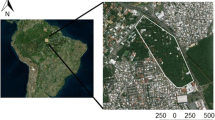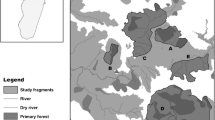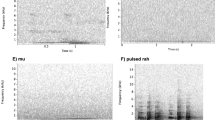Abstract
Vocalizations are used by group-living animals as aggressive and submissive signals during agonistic interactions, and are also used to maintain dominance hierarchies in many species. For gregarious strepsirrhines with large vocal repertoires and differentiated dominance ranks like the ring-tailed lemur (Lemur catta), agonistic vocalization use is important to study to better understand their social adaptations.To determine whether ring-tailed lemur vocalizations such as the yip, cackle, twitter, chutter, and plosive bark were used as aggressive or submissive signals during agonism and uttered at different rates by males of differing dominance ranks and ages, 565 h of focal data were collected on 31 individual males aged ≥ 1 year from Beza Mahafaly Special Reserve, Madagascar. Yip, cackle, and twitter vocalizations were consistently used during agonistic submissive interactions with both males and females, chutter vocalizations were used during aggressive agonistic interactions with males and submissive agonistic interactions with males and females, and plosive bark vocalizations were used across behavioural contexts but not particularly during agonism. Males of all ages employed all vocalizations, and while low-ranking males uttered yip calls at higher rates, males of all dominance ranks uttered cackle, twitter, chutter, and plosive bark vocalizations. These results advance our knowledge of how male lemurs utilize agonistic vocalizations to maintain inter-individual relationships with males and females, and improve our overall understanding of the function of different agonistic vocalizations in wild lemurs.








Similar content being viewed by others
References
Altmann J (1974) Observational study of behavior: sampling methods. Behaviour 49:227–265
Andrew R (1963) The origins and evolution of calls and facial expressions of the primates. Behaviour 20:1–109
Bastian A, Schmidt S (2008) Affect cues in vocalizations of the bat, Megaderma lyra, during agonistic interactions. J Acoust Soc Am 124:598
Bauers K (1993) A functional analysis of staccato grunt vocalizations in the stumptailed macaques (Macaca arctoides). Ethology 94:147–161
Beach F (1976) Sexual attractivity, proceptivity, and receptivity in female mammals. Horm Behav 7:105–138
Beehner J, Bergman T, Cheney D, Seyfarth R, Whitten P (2005) The effect of new alpha males on female stress in freeranging baboons. Anim Behav 69:1211–1221
Bernstein I (1991) An empirical comparison of focal and ad libitum scoring with commentary on instantaneous scans, all occurrence and one-zero techniques. Anim Behav 42:721–728
Bolt L (2013a) Squealing rate indicates dominance rank in the male ring-tailed lemur (Lemur catta). Am J Primatol 75:1174–1184
Bolt L (2013b) The function of howling in the ring-tailed lemur (Lemur catta). Int J Primatol 34:157–169
Bolt L (2013c) The relationship between dominance and vocal communication in the male ring-tailed lemur (Lemur catta). Dissertation, University of Toronto
Bolt L (2014) Male-specific use of the purr in the ring-tailed lemur (Lemur catta). Folia Primatol 85:201–214
Bolt L (2020a) Affiliative contact calls during group travel: chirp and wail vocalization use in the male ring-tailed lemur (Lemur catta). Folia Primatol 91:575–594.
Bolt L (2020b) Primate sensory systems. In: Vonk J, Shackelford T (eds) Encyclopedia of animal cognition and behavior. Springer, New York https://doi.org/10.1007/978-3-319-47829-6_1864-1
Bolt L, Tennenhouse E (2017) Contact calling behaviour in the male ring-tailed lemur (Lemur catta). Ethology 123:614–626
Bolt L, Sauther M, Cuozzo F, Antho Youssef J (2015) Antipredator vocalization usage in the male ring-tailed lemur (Lemur catta). Folia Primatol 86:124–133
Bradbury J, Vehrencamp S (1998) Principles of animal communication. Sinauer, Sunderland, MA
Budnitz N, Dainis K (1975) Lemur catta: ecology and behavior. In: Tattersall I, Sussman R (eds) Lemur biology. Plenum, New York, pp 219–235
Chapman A, Sussman R (eds) (2004) The origins and nature of sociality. Aldine de Gruyter, New York
Cheney D, Seyfarth R, Silk J (1995) The role of grunts in reconciling opponents and facilitating interactions among adult female baboons. Anim Behav 50:249–257
Clark A (1993) Rank differences in the production of vocalizations by wild chimpanzees as a function of social context. Am J Primatol 31:159–179
Clarke E, Reichard U, Zuberbühler K (2012) The anti-predator behavior of wild white-handed gibbons (Hylobates lar). Behav Ecol Sociobiol 66:85–96
Clutton-Brock T, Albon S (1979) The roaring of red deer and the evolution of honest advertisement. Behaviour 69:145–170
Cuozzo F, Sauther M (2006) Severe wear and tooth loss in wild ring-tailed lemurs (Lemur catta): a function of feeding ecology, dental structure, and individual life history. J Hum Evol 51:490–505
Cuozzo F, Sauther M, Gould L, Sussman R, Villers L, Lent C (2010) Variation in dental wear and tooth loss in known-aged, older ring-tailed lemurs (Lemur catta): a comparison between wild and captive individuals. Am J Primatol 72:1026–1037
Davies N, Halliday T (1978) Deep croaks and fighting assessment in toads (Bufo bufo). Nature 274:683–685
Fedurek P, Slocombe K, Zuberbuhler K (2015) Chimpanzees communicate to two different audiences during aggressive interactions. Anim Behav 110:21–28
Fichtel C, Kappeler P (2010) Human universals and primate symplesiomorphies: establishing the lemur baseline. In: Kappeler P, Silk J (eds) Mind the gap: tracing the origins of human universals. Springer, New York, pp 395–426
Freeberg T, Dunbar R, Ord T (2012) Social complexity as a proximate and ultimate factor in communicative complexity. Philos Trans R Soc Ser B 367:1785–1801
Gould L (1994) Patterns of affiliative behavior in adult male ringtailed lemurs (Lemur catta) at the Beza-Mahafaly Reserve, Madagascar. Dissertation, Washington University
Gould L (1997) Intermale affiliative behavior in ringtailed lemurs (Lemur catta) at the Beza-Mahafaly reserve, Madagascar. Primates 38:15–30
Gould L, Zeigler T (2007) Variation in fecal testosterone levels, inter-male aggression, dominance rank and age during mating and post-mating periods in wild adult male ring-tailed lemurs (Lemur catta). Am J Primatol 69:1325–1339
Gould L, Sussman R, Sauther M (2003) Demographic and life-history patterns in a population of ring-tailed lemurs (Lemur catta) at Beza Mahafaly Reserve, Madagascar: a 15-year perspective. Am J Phys Anthropol 120:182–194
Ichino S, Koyama N (2006) Social changes in a wild population of ringtailed lemurs (Lemur catta) at Berenty, Madagascar. In: Jolly A, Sussman R, Koyama N, Rasamimanana H (eds) Ringtailed lemur biology. Springer, New York, pp 233–244
Johnstone R (1996) Multiple displays in animal communication: “backup signals” and “multiple messages.” Philos Trans R Soc Ser B 351:329–338
Jolly A (1966) Lemur behavior: a Madagascar field study. University of Chicago Press, Chicago
Kitchen D, Seyfarth R, Fischer J, Cheney D (2003) Loud calls as indicators of dominance in male baboons (Papio cynocephalus ursinus). Behav Ecol Sociobiol 53:374–384
Kittler K, Schnoell A, Fichtel C (2015) Cognition in ring-tailed lemurs. Folia Primatol 86:106–116
Koyama N (1988) Mating behavior of ring-tailed lemurs (Lemur catta) at Berenty, Madagascar. Primates 29:163–175
Leger D (1977) An empirical evaluation of instantaneous and one-zero sampling of chimpanzee behavior. Primates 18:387–393
Macedonia J (1990) Vocal communication and antipredator behavior in the ringtailed lemur (Lemur catta). Dissertation, Duke University
Macedonia J (1993) The vocal repertoire of the ringtailed lemur (Lemur catta). Folia Primatol 61:186–217
Martin P, Bateson P (2007) Measuring behavior: an introductory guide, 3rd edn. Cambridge University Press, Cambridge, UK
Maynard Smith J (1982) Evolution and the theory of games. Oxford University Press, Oxford, UK
Mertl A (1976) Olfactory and visual cues in social interactions of Lemur catta. Folia Primatol 26:151–161
Mertl-Milhollen A, Gustafson H, Budnitz N, Dainis K, Jolly A (1979) Population and territory stability of the Lemur catta at Berenty, Madagascar. Folia Primatol 31:106–122
Mertl-Millhollen A (2006) Scent marking as resource defense. Am J Primatol 68:605–621
Nakamichi M, Koyama N (1997) Social relationships among ring-tailed lemurs (Lemur catta) in two free-ranging troops at Berenty Reserve, Madagascar. Int J Primatol 18:73–93
O’Mara M (2012) Development of feeding in ring-tailed lemurs. Dissertation, Arizona State University
Otter K, Chruszcz B, Ratcliffe L (1997) Honest advertisement and song output during the dawn chorus of black-capped chickadees. Behav Ecol 8:167–173
Parga J (2006) Male mate choice in Lemur catta. Int J Primatol 27:107–131
Parga J (2009) Dominance rank reversals and rank instability among male Lemur catta: the effects of female behavior and ejaculation. Am J Phys Anthropol 138:293–305
Parga J (2013) Male reproductive senescence in the ring-tailed lemur (Lemur catta). Am J Phys Anthropol 150:216
Pereira M (1995) Development and social dominance among group-living primates. Am J Primatol 37:143–175
Pereira M, Kappeler P (1997) Divergent systems of agonistic behaviour in lemurid primates. Behaviour 134:225–274
Pflüger F, Fichtel C (2012) On the function of redfronted lemur’s close calls. Anim Cogn 15:823–831
Pride R (2005) Optimal group size and seasonal stress in ring-tailed lemurs (Lemur catta). Behav Ecol 16:550–560
Rhine R, Linville A (1980) Properties of one-zero scores in observational studies of primate social behavior: the effect of assumptions on empirical analyses. Primates 21:111–122
Robinson G (1982) Vocal systems regulating within-group spacing. In: Snowdon C, Brown C, Peterson M (eds) Primate communication. Cambridge University Press, Cambridge, UK, pp 94–116
Sarfaty A, Margulis S, Atsalis S (2012) Effects of combination birth control on estrous behavior in captive western lowland gorillas, Gorilla gorilla gorilla. Zoo Biol 31:350–361
Sauther M (1991) Reproductive behavior of free-ranging Lemur catta at Beza Mahafaly Special Reserve, Madagascar. Am J Phys Anthropol 84:463–477
Sauther M (1993) Resource competition in wild populations of ringtailed lemurs (Lemur catta): implications for female dominance. In: Kappeler P, Ganzhorn J (eds) Lemur social systems and their ecological basis. Springer, Boston, pp 135–152
Sauther M (2002) Group size effects on predation sensitive foraging in wild ring-tailed lemurs (Lemur catta). In: Miller L (ed) Eat or be eaten: predator sensitive foraging among primates. Cambridge University Press, Cambridge, UK, pp 107–125
Sauther M, Cuozzo F (2008) Somatic variation in living, wild ring-tailed lemurs (Lemur catta). Folia Primatol 79:55–78
Sauther M, Cuozzo F (2009) The impact of fallback foods on wild ring-tailed lemur biology: a comparison of intact and anthropogenically disturbed habitat. Am J Phys Anthropol 140:671–686
Sauther M, Sussman R (1993) A new interpretation of the social organization and mating system of the ringtailed lemur (Lemur catta). In: Kappeler P, Ganzhorn J (eds) Lemur social systems and their ecological basis. Plenum, London, pp 111–122
Sauther M, Sussman R, Gould L (1999) The socioecology of the ringtailed lemur: thirty-five years of research. Evol Anth 8:120–132
Sauther M, Sussman R, Cuozzo F (2002) Dental and general health in a population of wild ring-tailed lemurs: a life history approach. Am J Phys Anthropol 117:122–132
Suen H, Ary D (1984) Variables influencing one-zero and instantaneous time sampling outcomes. Primates 25:89–94
Sullivan R (1982) Agonistic behavior and dominance relationships in the harbor seal, Phoca vitulina. J Mammal 63:554–569
Sussman R (1991) Demography and social organization of free-ranging Lemur catta in the Beza Mahafaly Reserve, Madagascar. Am J Phys Anthropol 84:43–58
Sussman R (1992) Male life history and intergroup mobility among ringtailed lemurs (Lemur catta). Int J Primatol 13:395–413
Sussman R, Ratsirarson J (2006) Beza Mahafaly Special Reserve: a research site in southwestern Madagascar. In: Jolly A et al (eds) Ringtailed lemur biology: Lemur catta in Madagascar. Springer, New York, pp 43–51
Sussman R, Richard A, Ratsirarson J, Sauther M, Brockman D, Gould L, Lawler R, Cuozzo F (2012) Beza Mahafaly Special Reserve: a research site in southwestern Madagascar. In: Kappeler P, Watts D (eds) Long term field studies of primates. Springer, New York, pp 54–66
Suzuki M, Sugiura H (2011) Effects of proximity and activity on visual and auditory monitoring in wild Japanese macaques. Am J Primatol 73:623–631
Taylor L (1986) Kinship, dominance, and social organization in a semi-free ranging group of ringtailed lemurs (Lemur catta). Dissertation, Washington University
Taylor L, Sussman R (1985) A preliminary study of kinship and social organization in a semi-free-ranging group of Lemur catta. Int J Primatol 6:601–614
Tennenhouse E (2016) Unique lemur traits: proximate and ultimate perspectives. Dissertation, University of Toronto
Tennenhouse E, Putman S, Boisseau N, Brown J (2017) The relationship between steroid hormones in hair and social behaviour in ring-tailed lemurs (Lemur catta). Primates 58:199–209
van Horn R, Resko J (1977) Reproductive cycle of the ringtailed lemur (Lemur catta): sex steroid levels and sexual receptivity under controlled photoperiods. Endocrinol 101:1579
Walker-Bolton A (2017) Male mating success in Lemur catta. Dissertation, University of Toronto
Walker-Bolton A, Parga J (2017) “Stink flirting” in ring-tailed lemurs (Lemur catta): male olfactory displays to females as honest, costly signals. Am J Primatol 79:e22724
Zumpe D, Michael R (1986) Dominance index: a simple measure of relative dominance status in primates. Am J Primatol 10:291–300
Acknowledgements
I am grateful to Jacky Ibrahim Antho Youssouf and Andry Randrianandrasana at the Beza Mahafaly Special Reserve, Madagascar Institut pour la Conservation des Ecosystèmes Tropicaux, and Jeannin Rainavanosy and Joel Ratsirarson at the Département des Eaux et Forêts de l’Ecole Supérieure des Sciences Agronomiques (ESSA) and Madagascar National Parks (MNP) (formerly l'Association Nationale pour la Gestion des Aires Protégées; ANGAP) for their facilitation of this project. I thank Enafa, Elahavelo, Efitiria, Edouard, Ralaevo, and Monja of the Beza Mahafaly Ecological Monitoring Team for field assistance, and Michelle Sauther and Frank Cuozzo for sharing ring-tailed lemur age data. I am grateful to Ryan Janzen and Heather Hummel for their companionship and stimulating conversation during COVID-19 lockdown, while I wrote this paper. I also thank Eugenia Tsao for technological support and Joyce Parga for mentorship. Finally, I thank the editor-in-chief, associate editor, and two anonymous reviewers, whose comments have improved this paper. Funding was provided by the Natural Sciences and Engineering Research Council of Canada (Alexander Graham Bell Canada Graduate Scholarship, Doctoral Award), the American Museum of Natural History, Ontario Graduate Scholarships, the Edward. J. Noble Foundation, the St. Catherines Island Foundation, General Motors Women in Science, and the University of Toronto.
Author information
Authors and Affiliations
Corresponding author
Ethics declarations
Conflict of interest
None.
Ethical approval
The data collection adhered to the legal requirements of Madagascar. Data were collected with the approval of ESSA and MNP (formerly ANGAP). This research complied with the ethical standards for the treatment of animals corresponding with the guidelines laid down by the Primate Society of Japan, the National Institutes of Health (USA), and the European Commission. The research protocol met all the aforementioned guidelines for the use of animals in research and was approved by the University of Toronto Animal Care Committee.
Additional information
Publisher's Note
Springer Nature remains neutral with regard to jurisdictional claims in published maps and institutional affiliations.
About this article
Cite this article
Bolt, L.M. Agonistic vocalization behaviour in the male ring-tailed lemur (Lemur catta). Primates 62, 417–430 (2021). https://doi.org/10.1007/s10329-020-00878-3
Received:
Accepted:
Published:
Issue Date:
DOI: https://doi.org/10.1007/s10329-020-00878-3




